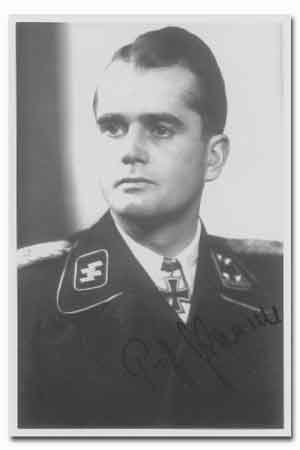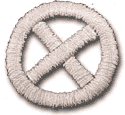
SS-Obersturmbannführer
Paul-Albert Kausch
Träger
des Eichenlaube zum Ritterkreuz des Eiserne Kreuz

Paul-Albert Kausch entered the Leibstandarte Adolf Hilter in 1933. His training was undertaken at Jüterborg with the Infanterie-Regiment 9. In 1935, Kausch attended the Junkerschule (OCS) in Braunschweig and was promoted to Untersturmführer on 20 April 1936. For the next three years until 1939 as a Obersturmführer, Kausch was assigned as both Zug- and Kompanieführer in the Totenkopf-Standarten 3 and 1, as well as a Kompanieführer in the 8./Infanterie-Regiment 11 (Heer). Kausch attended the Kompanie- and Bataillonführerlehrgang at the Infanterieschule Döberitz. On 20 April 1939, Kausch was promoted to Hauptsturmführer. In November 1939, Kausch was assigned as Batteriechef 5./Artillerie-Regiment Totenkopf. In February 1940, Kausch attended the Abteilungs-Führerlehrgang at the Artillerieschule Jüterborg (Heer). During the campaign against France in 1940, Kausch earned the Iron Cross 1st Class. In November 1940, Kausch was transferred to the Wiking Division where he served as the Divisional Adjutant.
From August 1941 until January 1942, Kausch served as Kommandeur, I./Artillerie-Regiment "Wiking". On 20 April 1942, Kausch was promoted to Sturmbannführer. In December, Kausch was ordered to the Panzerabteilungs-Führerlehrgang at the school for Fast Troops in Paris.
In February 1943, Kausch was tasked with the organization of the SS-Panzer-Abteilung 11 "Nordland" (later known as "Hermann von Salza").
Christmas 1943, Kausch was ordered to the Northern Front where he was commited with tanks in the Oranienbaumer Kessel (dug-in MK V "Panther" tanks) followed by a withdrawal to the Narwa. A large portion of his tanker-men were converted to infantry. Between Hungerburg and Riigi, countless Soviet attacks were repelled and the few remaining tanks were committed to the bridgehead at Narwa. Here, SS-Oberscharführer Wild was decorated with the Knight's Cross. After 5 months of action at the Narwa, Kausch was promoted to Obersturmbannführer.
In July 1944, Kausch was assigned as Kampfgruppenkommandeur (task force commander) for sector of a swamp along the Lipsustraße, which included the 1./Pi.-Btl.11 and portions of his tanker-converted infantrymen. With only a small number of men, Kausch held a sector of the front throughout the night. However, the Soviets had broken throught the lines of the Pi.Btl.11 and were closing on Kausch's command post. With hand grenades and an StG44 assault rifle, but no uniform jacket or cap, Kausch sounded the alarm with his small force. Kausch then ordered an Army forward observer to call for fire on his own position. Shortly thereafter, Kausch was picked up by a Schützenpanzerwagen (SPW), which joined reserves that had been committed to battle. For this action, SS-Obersturmbannführer Kausch was decorated with the Knight's Cross on 23 August 1944.
After withdrawing out from the swamps, Kausch was reassigned as Panzerführer during the fighting around the Grenadier- and Kinderheimhöhe (orphanage). During the fighting Kausch was wounded and brought to the Field Hospital Reval, but shortly thereafter Kausch rejoined his troops.
In October 1944, German forces evacuated the Kurland, across the Baltic Sea, and returned into the Reich. However, the 1.Kompanie remained in the Kurland along with it's tanks until February 1945.
As a Regimentsführer, Kausch commanded the newly organized formation around the area of Hammerstein (west Prussia) that included the Panzerabteilung 11, schwere SS-Panzerabteilung 503, and SS-Panzerjäger-Abeitlung 11 (fitted with Sturmgeschützen). Fighting withdrawals were conducted through Pommern, Reetz, Arnswalde, Kleinsilber, which resulted in the death of the commander of the 1.Kompanie, SS-Hauptsturmführer Rott, posthumously awarded the Knight's Cross, and finally at the bridgehead at Stettin.
Around the middle of April 1945, Kausch participated in the final large-scale counterattacks eastward from Strausberg that resulted, at the onset, in considerable success. Fighting a withdrawal to Berlin, Kausch and his men participated in the very last battles. As the 845th soldier, Kausch was awarded oak leaves to the Knight's Cross on 23 April 1945. Two days later, Kausch was summoned to the Reichskanzlei and tasked with the so-called "inner-ring" tank defense. The companies had already suffered extensive casualties. The Pi.Erkunder-Zug (engineer reconnaissance platoon), was made up of men from the Luftwaffe and Kriegsmarine. By 2 May 1945, only the platoon commander and 15 men survived, the remaining men were either killed, wounded, or missing.
On 28 April 1945, Kausch was severely wounded for the third time. On 1 May 1945, laying inside a Schützenpanzerwagen (halftrack), he was brought to the field hospital Hotel Aldon) after an escape along the Friedrichsstraße Railroad Station. Kausch then entered Soviet captivity until 16 January 1956.
Tank Battle before Berlin
The SS-Panzer-Abteilung "Hermann von Salza", under the new command of SS-Hauptsturmführer Grathwol, consisted of the I.Abteilung, whereas the schwere SS-Panzer-Abteilung 503, commanded by SS-Sturmbannführer Herzig, made up the II.Abteilung of the new SS-Panzerregiment 11, commanded by SS-Obersturmbannführer Kausch.
Many members from both tank
battalions that participated in the bitter fighting in and around Berlin were
unable to accept the reality of creating a tank regiment from two nominal tank
battalions. On 13 April 1945, Herzig reported 12 operational "Königstiger" (King
Tiger) tanks, located in Frauenhagen near Schwedt. In mid-April, the SS-Panzer-Abteilung
11 had 45-50 Sturmgeschütze (StuG), individual Panzer IV and V ("Panther"),
and 10 Jagdpanzer "Hetzer" (7,5mm KwK 40). In addition, the regiment also had
armored vehicles form the headquarters and staff companies, such as the Erkundungszug
"Hermann von Salza."
The regimental commander, SS-Obersturmbannführer Kausch, intended on applying the successful Soviet "Panzer-Rudeltaktik" (tactical concentration of tanks). In this respect, the Königstigers and StuGs or Panthers from both Abteilungen were to operate as tactical task forces or "Rammböcke" (battering rams) that intergrated infantry for close-in protection and security. Six Panzerrudeln, each with Königtigers and approximately 10 Panzer, were envisioned by Kausch. However, due to the lack of time, Kausch could not organize his forces in such a manner. Only ten days after his arrival as the regimental commander during the beginning of April, the SS-Pz.Rgt.11 was enroute to the front.
On 17 April, Hilter and the OKH released the Heeresgruppenreserve of the 3.Panzerarmee, consisting of the Divisions "Nordland" and "Nederland", after numerous pleas by General Busse, to the operational area of the 9. Armee as a result of a crisis that had developed around Wriezen and Seelow. By 2400 hours, Heeresgruppe Weichel reported the first elements of the Division "Nordland" enroute (the SS-Panzeraufklärungs-Abteilung 11 had preceeded the advance in the direction of Seelow). The small village of Buckow along the Scharmützelsee (Märkische Schweiz) lay between a dense forest that spread across a high hill with troughs and eroded sink-holes. The Swiss terrain constituted a considerable obstacle for the First and Second Ukrainian Guard Tank Armies that were forced to traverse the geographic obstacle on either side. North of Buckow (Batzlow-Ringenwalde-Grunow-Prötzel-Reichenow), along the high-ground and flat plateau, the terrain was ideal for tanks. As a result, the plateau became a key tactical objective for both the German defenders and Soviet attackers.
Despite the successful gains of the First White Russian Front, the second large-scale battle of 17 April was as much a Soviet disaster as the battle from the previous day. Soviet loses were at such high levels that Chukov was forced to comb through all rear areas for additional infantry.
On 18 April, 0300 hours, the Pz.AOK 3 reported to HG Weichel that the SS-Pz.Rgt.11 was enroute via Eberswalde-Heckelberg-Tiefensee-Geiseldorf-Strausberg. The companies of the regiment "Hermann v. Salza" arrived piecemeal in the area of Strausberg. The same day, elements of the Soviet Second Guard Tank Army reached the plateau heights north of Buckow and advanced against Batzlow, Ringenwalde and Reichenberg with approximately 60 tanks. Good weather allowed the Soviet airforce to support the attacks en masse.
Kausch arrived with his regimental adjutant, SS-Hauptsturmführer v.Renteln, early in the afternoon in the area of Buckow. Moving forward to Strausberg-Buckow he observed the situation. Withdrawing Fallschirmjäger indicated that the Soviets were attacking with 100 tanks and asked for assistance. Kausch would not attack but waited for the enemy's arrival.
Officers of the Fallschirmjäger-Division 9 instructed Kausch to deploy his tanks defensively within a long erosional slit. A seasoned tank commander, Kausch deployed his tanks and StuGs, which were arriving one after the other, behind a rise west of Reichenberg. Soon thereafter, 70 Soviet tanks approached their position from Ringenwalde. Taken by surprise in the open terrain, 50 Soviet tanks were destroyed. A regimental residual "Panther" tank, left over from the Narwa-Front, was immoblized at the Prötzel crossroad after experiencing engine trouble. Even so, the Panther managed to destroy 8 of 20 Soviet T-34 tanks that had broken through and prevented the enemy's continued advance.
Königstiger between Klosterdorf and Grunow
In the early morning hours on 19 April, four Königstiger of the s.SS-Pz.Abt.503, under the command of Obersturmführer Müller, rolled through the village of Klosterdorf north of Strausberg. The tanks were emplaced east of the Black Mountains with their guns facing Prädikow-Grunow. One of the 4 Tigers was hull number 314 (commanded by Georg Diers, gunner Wolf-Dieter Kothe, loader Alex Sommer, driver Willi Kenkel, and radio operator Bodo Harms).
The first Soviet tanks, supported by infantry, began to appear across a broad front around 1000 hours between Ihlow and Grunlow. At a range of approximately 400 meters, the Tigers opened fire and quickly destroyed approx. 40-50 Soviet T-34 tanks. The hilly terrain allowed many of the Soviet tanks to escape disaster and seek cover. While the Tiger-defense became more difficult as burning tanks billowed thick smoke that reduced their ability to see, Tiger machine gun fire also caused considerable losses and forced the Soviet infantry withdrew.
After the first wave of tanks, the Soviets attacked again, around 1400 hours, across a broad front. By 1600 hours the attacked had failed. Without a single loss, 4 Königstiger managed to destroy 105 of over 400 Soviet tanks. By 1600, supply vehicles brought fuel and ammunition. Two Tigers were then deployed about 800 meters back within the forest while 2 Tigers remained in position for security. Shortly thereafter, the forest was hit by a heavy rocket barrage. Both tanks and crews, execpt for 2 men, were lost. Ostuf.Müller was among the dead.
Low on ammunition, Feldwebel Körner and Diers (Tiger 314) provided security. Along the heights between Ihlow and Reichenow, at a great distance of approx. 1800 meters, four hay piles were observed. Through his binoculars, Georg Diers saw a fireball coming from one of the plies of hay. Diers also recognized the silhouette of a 122mm Joseph Stalin tank that fired at their tank. From the turret, Diers watched the tank projectile sail through the air. Shortly before impact on the turret, he ducked down inside the tank. The Soviet round tore the vision blocks apart, ripped the hatches off the tower, and partially blew the coning tower off the turret. Unfortunately, the telescopic sight was damaged that rendered the tank inoperable.
After 20 April, the SS-Panzerregiment 11, attached to the LVI.Pz.Korps, began a general withdrawal over Strausberg to the outskirts of greater Berlin.
Tiger 314 was driven to a repair facility on a farm in Altlandsberg. Subsequently, Tiger 314 fought as an individual tank in the center of Berlin and ended the war with 39 victories. The crew survived the war.
